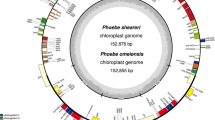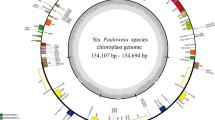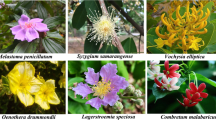Abstract
Allium is a very diverse genus with over 600 species distributed worldwide. Haplotype analyses of 45S rRNA ITS, trnH-psbA spacer, and matK gene sequences in 9 Allium species were carried out, subsequent to which phylogenetic relations of the nine species were also analyzed. Of the three genes, the nuclear 45S rRNA ITS sequences showed the highest variation with one haplotype in each species. The other two chloroplast genes revealed that more than one haplotype was present in each species, and each haplotype was present in several of the species. In the matK gene, EcoRI restriction revealed heteroplasmy in which the functional gene retains the EcoRI recognition site while the nonfunctional, pseudogene does not. Phylogenetic patterns were not consistent among the haplotypes of the 45 rRNA ITS, trnH-psbA spacer, and matK genic regions. This phylogenetic incongruency might be due to the presence of multiple haplotypes in each of the chloroplast genes. However, the inconsistency of the phylogenetic relationships, based on the 45S rRNA ITS sequences makes a strong case for further analysis.
Similar content being viewed by others
References
Berg von GL, Samylov A, Klaas M and Hanelt P (1996) Chloroplast DNA restriction analysis and intragenic grou** of Allium (Alliaceae). Pl. Syst. Evol. 200: 253–261.
Birky Jr CW (2001) The inheritance of genes in mitochondria and chloroplasts: laws, mechanisms, and models. Annu. Rev. Genet. 35: 125–148.
Blaxter ML (2004) The promise of a DNA taxonomy. Phil. Trans. R. Soc. Lond. B. 359: 669–679.
Do GS, Seo BB, Ko JM, Lee SH, Pak JH, Kim IS and Song SD (1999) Analysis of somaclonal variation through tissue culture and chromosomal localization of rDNA sites by fluorescent in situ hybridization in wild Allium tuberosum and a regenerated variant. Plant Cell Organ Cult. 57: 113–119.
Do GS, Seo BB, Yamamoto M, Suzuki G and Mukai Y (2001) Identification and chromosomal location of tandemly repeated DNA sequences in Allium cepa. Genes Genet. Syst. 76: 53–60.
El-Gadi A and Elkington TT (1975) Comparison of the Giemsa C-band karyotypes and the relationships of Allium cepa, A. fistulosum and A. galanthum. Chromosoma 51: 19–23.
El-Gadi A and Elkington TT (1977) Numerical taxonomic studies in Allium subgenus Rhizirideum. New Phytol. 79: 183–201.
Erixon P and Oxelman B (2008) Whole-gene positive selection, elevated synonymous substitution rates, duplication, and in/del evolution of the chloroplast clpP1 gene. PLoS One 3: 1386.
Faure S, Noyer JL, Carreel F, Horry JP, Bakry F and Lanaud C (1994) Maternal inheritance of chloroplast genome in bananas (Musa acuminate). Curr. Genet. 25: 265–269.
Friesen N, Pollner S, Bachmann K and Blattner FR (1999) RAPDs and noncoding chloplast DNA reveal a single origin of the cultivated Allium fistulosum subgenus from A. altaicum (Alliaceae). Am. J. Bot. 86: 554–562.
García-Díaz A, Oya R, Sánchez A and Luque F (2003) Effect of prolonged vegetative reproduction of olive tree cultivars (Olea europaea L.) in mitochondrial homoplasmy and heteroplasmy. Genome 46: 377–381.
Gu JY, Dempsey S and Newton KJ (1994) Rescue of a maize mitochondrial cytochrome oxidase mutant by tissue culture. Plant J. 6: 788–794.
Hajibabaei M, Singer GAC, Hebert PDN and Hickey D (2007) DNA barcoding: how it complements taxonomy, molecular phylogenetics and population genetics. Trends in Genet. 23: 167–172.
Hao G, Lee DH, Lee JS and Lee NS (2002) A study of taxonomical relationships among species of Korean Allium sec. Sacculiferum (Alliaceae) and related species using inter simple sequence repeat (ISSR) markers. Bot. Bull. Acad. Sin. 43: 63–68.
Havey MJ (1991) Phylogenetic relationships among cultivated Allium species from restriction enzyme analysis of the chloroplast genome. Theor. Appl. Genet. 81: 752–757.
Havey MJ (1992) Restriction enzyme analysis of the chloroplast and nuclear 45S ribosomal DNA of Allium sections Cepa and Phyllodolon (Alliaceae). Pl. Syst. Evol. 183: 17–31.
Havey MJ (1995) Simmonds NW}, eds., 2nd edition, Wiley Pub. Co., New York, pp. 344–350.
Hebert PDN, Alina C, Shelley LB and Jeremy RW (2003) Biological identifications through DNA barcodes. Proc. R. Soc. Lond. B. Biol. Sci. 270: 313–321.
Houliston GJ and Olson MS (2006) Nonneutral evolution of organelle genes in Silene vulgaris. Genetics 174: 1983–1994.
Hsiao C, Chatterton NJ, Asay KH and Jensen KB (1995) Phylogentic relationships of the monogenomic species of the wheat tribe, Triticeae (Poaceae), inferred from nuclear rDNA (internal transcribed spacer) sequences. Genome 38: 221–223.
Hurst LD (2002) The Ka/Ks ratio: diagnosing the form of sequence evolution. Trends in Genet. 18: 486–487.
Ipek M, Ipek A and Simon P (2008) Genetic characterization of Allium tuncelianum: an endemic edible Allium species with garlic ordor. Sci. Hort. 115: 409–415.
Irifune K, Hirai K, Zheng J, Tanaka R and Morikawa H (1995) Nucleotide sequence of a highly repeated DNA sequence and its chromosomal localization in Allium fistulosum. Theor. Appl. Genet. 90: 312–316.
Jobes D and Thien L (1997) A conserved motif in the 5.8S ribosomal RNA (rRNA) gene is a useful marker for plant internal transcribed spacer (ITS) sequences. Plant Mol. Biol. Rep. 15: 326–334.
Kovarik A, Matyasek R, Lim KY, Skalicka K, Koukalova B, Knap S, Chase M and Leitch AR (2004) Concerted evolution of 18-5.8-26S rDNA repeats in Nicotiana allotetraploids. Biol. J. Linn. Soc. 82: 615–625.
Kress WJ, Wurdack KJ, Zimmer EA, Weight LA and Janzen DH (2005) Use of DNA barcodes to identify flowering plants. Proc. Natl. Acad. Sci. USA 102: 8369–8374.
Lahaye R, van der Bank M, Bogorin D, Warner J, Puplin F, Gigot G, Maurin O, Duthoit S, Barrclough TG and Savolanien V (2008) DNA barcoding the floras of biodiversity hotspots. Proc. Natl. Acad. Sci. USA 105: 2923–2928.
Liu Q, Ge S, Tang H, Zhang X, Zhu G and Lu BR (2006) Phylogenetic relationships in Elymus (Poaceae: Triticeae) based on the nuclear ribosomal internal transcribed spacer and chloroplast trnL-F sequences. New Phytol. 170: 411–420.
Mes THM, Fritsch RM, Pollner S and Bachmann K (1999) Evolution of the chloroplast genome and polymorphic ITS regions in Allium subg. Melanocrommyum. Genome 42: 237–247.
Mogensen HL (1996) The hows and whys of cytoplasmic inheritance in seed plants. Am. J. Bot. 83: 383–404.
Pich U, Fritsch R and Schubert I (1996) Closely related Allium speices (Alliaceae) share a very similar satellite sequence. Pl. Syst. Evol. 202: 255–264.
Ricroch A, Peffley EB and Baker RJ (1992) Chromosomal location of rDNA in Allium: in situ hybridization using biotin- and fluorescent-labelled probe. Theor. Appl. Genet. 83: 413–418.
Shibata F and Hizume M (2002) Evolution of 5S rDNA units and their chromosomal localization in Allium cepa and Allium schoenoprasum revealed by microdissection and FISH. Theor. Appl. Genet. 105: 167–172.
Son SW, Kim JH, Kim KJ and Park SJ (2009) Molecular evidence for the hybridity of Ilex x wandoensis and the phylogenetic study of Korean Ilex based on ITS sequence data. Genes Genomics. 31: 53–63.
Traub H (1968) The order of Allium. Plant Life 24: 129–138.
Van Raamsdonk LWD, Ginkel MV and Kik C (2000) Phylogeny reconstruction and hybrid analysis in Allium subgenus Rhizirideum. Theor. Appl. Genet. 100: 1000–1009.
Vvdensky A (1944) The genus Allium in USSR. Herbertia 11: 65–218.
Wintz H (1994) Analysis of heteroplasmy in a cytoplasmic mutant maize. Plant Physiol. Biochem. 32: 649–653.
Yamashita KI, Oyama T, Noda R, Miyazaki T and Tashiro Y (1998) Comparative study on methods for identification of chloroplast DNA of cultivated and wild species in section Cepa of Allium. Bull. Fac. Agr. Saga Univ. 83: 111–120.
Yonemori K, Honsho C, Eiadthong K and Sugiura A (2002) Phylogenetic relationships of Manngifera species revealed by ITS sequences of nuclear ribosomal DNA and a possibility of their hybrid origin. Plant Syst. Evol. 231: 59–75.
Young ND and dePamphilis CW (2000) Purifying selection detected in the plastid gene matK and flanking ribozyme regions within a group II intron of nonphotosynthetic plants. Mol. Biol. Evol. 17: 1933–1941.
**ngyi G, Songlin R, Weiming H, Daguang C, and Longjiang F (2008) Chloroplast DNA insertions into the nuclear genome of rice: the genes, sites and ages of insertion involved. Funct. Integr. Genomics 8: 101–108.
Zhang D and Sang T (1999) Physical map** of ribosomal RNA genes in Peonies (Paeonia, Paoniaceae) by fluorescent in situ hybridization: implications for phylogeny and concerted evolution. Amer. J. Bot. 86: 735–740.
Zhong Y, Zhao Q, Shi S, Huang Y and Hasegawa M (2002) Detecting evolutionary rate heterogeneity among mangroves and their close terrestrial relatives. Ecol. Lett. 5: 427–432.
Author information
Authors and Affiliations
Corresponding author
Additional information
An erratum to this article is available at http://dx.doi.org/10.1007/s13258-010-0630-4.
Rights and permissions
About this article
Cite this article
Son, JH., Park, KC., Kim, TW. et al. Sequence diversification of 45S rRNA ITS, trnH-psbA spacer, and matK genic regions in several Allium species. Genes Genom 32, 165–172 (2010). https://doi.org/10.1007/s13258-009-0849-0
Received:
Accepted:
Published:
Issue Date:
DOI: https://doi.org/10.1007/s13258-009-0849-0




